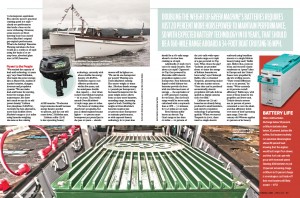[vc_row type=”in_container” full_screen_row_position=”middle” scene_position=”center” text_color=”dark” text_align=”left” overlay_strength=”0.3″ shape_divider_position=”bottom” bg_image_animation=”none”][vc_column column_padding=”no-extra-padding” column_padding_position=”all” background_color_opacity=”1″ background_hover_color_opacity=”1″ column_link_target=”_self” column_shadow=”none” column_border_radius=”none” width=”1/1″ tablet_width_inherit=”default” tablet_text_alignment=”default” phone_text_alignment=”default” column_border_width=”none” column_border_style=”solid” bg_image_animation=”none”][vc_column_text]Electric motors and battery capacity will exceed the horsepower and range of gas engines and a tank full of fuel. When that happens, internal combustion engines may vanish as quickly as a stack of $20s at the gas dock. How soon will that happen? Likely before first-graders today are ready to buy their first boat, and possibly before they’re in college. Says who? We went aboard electric boats and talked to industry insiders for the scoop on electric boating’s future. Come aboard as we explore 100 years of electric boat development.
In the Beginning “Over a period of 30 years, boats went through five different methods of propulsion: steam, naphtha, electric, gasoline and diesel,” exclaims Joseph Fleming, the head of engineering for Elco, builders of electric boats and propulsion systems. But practical, safe motorboating began at the 1893 Chicago World’s Fair, where 55 electric launches ferried attendees. The fair was the first-ever large scale use of electricity. “At the time, electric boats were most practical,” Fleming says.
Consider Wenona, a 32-foot launch built in 1899 by the Electric Launch Co. — now Elco — the company that built those World’s Fair launches. A 5 hp electric motor pushed Wenona at 7 mph for more than 60 miles between charges without smoke, soot, noise or open flame.
What happened to electric-powered boats? Gottlieb Daimler invented the high-speed gasoline engine, which he used in 1886 to propel a 15-foot skiff along at 7 mph — the first gas-powered boat, and Rudolf Diesel ran his first successful prototype engine in 1893. “By the end of World War I, gasoline engines became the preferred propulsion for boats,” Fleming says. At the time, boats could go faster and farther on liquid fuel than they could on batteries.
[/vc_column_text][/vc_column][/vc_row]
